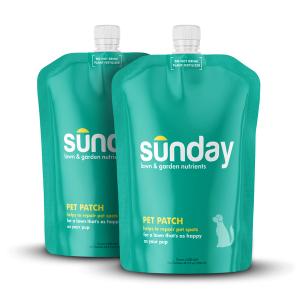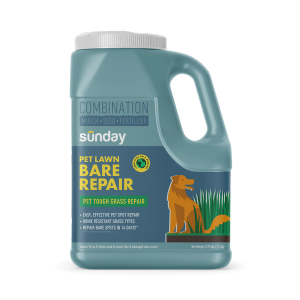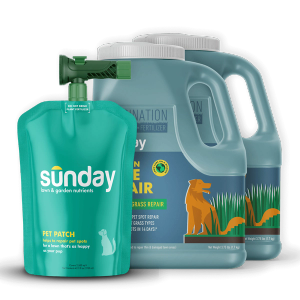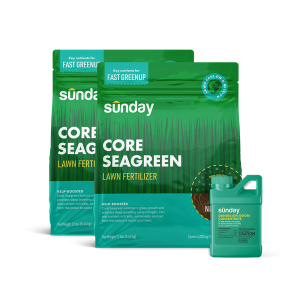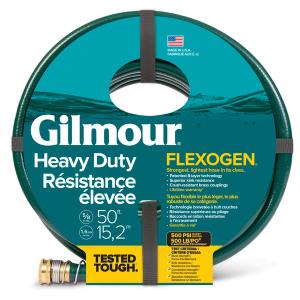Disclaimer: Adjusting your pH is very difficult to do. Plus, most turfgrasses can tolerate a wide range of pH levels in lawns. We recommend considering how critical this practice is for your lawn’s success prior to liming.
What is lime?
Lime is a calcium or calcium magnesium compound commonly used to adjust the pH in lawns. Liming is the actual practice of applying lime across the lawn to adjust soils that are too acidic (low pH).
What does lime do for your lawn?
We know lime helps adjust soil pH properties. But did you know it adds required nutrients for plant growth—like calcium and magnesium—to your soil? It also promotes increased availability of other nutrients for your grass. When used correctly, it can improve growing conditions for grass in acidic soils.
How to tell if your lawn needs lime
Make sure to test your soil first
Sunday’s Custom Lawn Plan provides you with a free soil test that will help you understand the chemical makeup of your lawn.
Know what pH Sunday considers lime-worthy
Turf can tolerate a wide range of pH, but anywhere between 5.5–8.5 can be considered optimal for growth. Sunday considers a lawn slightly too acidic if pH falls below 5.5. It’s not out of the question to consider liming if you’re well below that number.
Determine if your grass type is tolerant of acidic soils
Cool-season grasses like tall fescue, fine fescues, and bentgrasses are generally more tolerant. As far as warm-season grasses go, centipedegrass, bermudagrass, seashore paspalum, and zoysiagrass are more tolerant than others. If your grass is more tolerant to acidic soils, you may not need to lime!
Consider your location
Certain locations are more prone to acidic soils than others due to excessive rainfall or irrigation, while dry regions or areas with high-salt irrigation tend to have more basic soil (high pH). A few places across the U.S. that tend to see acidic soils are those where sandy soils are common and prone to nutrient leaching.
When to apply lime to lawn
Fall or spring are ideal times to lime when the potential for rainfall and mild weather is high.
Other helpful tips:
- Try to apply lime prior to anticipated rainfall to help move lime into the soil, reduce the potential for turf injury, and help reduce lime dust particle movement.
- Don’t apply lime to frozen ground, frost or snow-covered grass, or stressed grass.
- Avoid applying on windy days to reduce dust inhalation or eye irritation by you or your neighbors.
- If you moved to a new home and have a low pH, apply lime before establishing a new lawn. This will help mix lime into the soil as it’s harder to move into the soil later on.
What lime should I use?
Sunday recommends using calcium carbonate. It’s the most abundant and commercially available lime which makes it more affordable. Plus, it’s the least caustic (prone to burning) which makes it easy to handle and apply.
Sunday Tip:
There are other forms of lime like calcium oxide (“burnt” lime) and calcium hydroxide (“hydrated” lime), but these forms are caustic, or more dangerous to handle and apply to your lawn.
How to lime your lawn
- Select the right type of lime product. The smaller the lime particle, the better the lime will be incorporated into your soil.
- Apply with a hand spreader or push spreader. This ensures even application of the product. Never apply more than 50 pounds of calcium carbonate lime in a single application to avoid burning your grass or overapplying.
- Water in the lime. If you apply before a rain event, allow the rain to water in the product. If rain is not expected, water in the product with a regular irrigation cycle (around 30 minutes).
- Wait for lime to improve pH. You may need to wait a few months for soil pH levels to adjust. Ideally, you should test the soil again before reapplying lime to reduce the potential of causing alkaline soil, or overapplying lime.
Should I consider planting something else in my acidic soil?
Yes! Even the best lime application may not adjust your soil’s pH as expected. If this happens, consider replacing grass with landscape plants that are compatible with acidic soil, replacing these areas of the lawn with hardscape (like mulch), or allowing plants like moss (they love acidic soils!) to cover the ground.
Cited sources
Lime and Lawns. University of Maryland Extension.
Lime and the Home Lawn. Ohio State University Extension.
Liming the Lawn. West Virginia University Extension.



